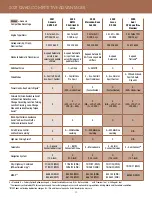
GENESIS RESouRcE LISt
· The vehicle drives at night or in the darkness
· There is an item similar to a person’s body structure
· The pedestrian or cyclist is small
· The pedestrian has impaired mobility
· It is difficult to distinguish the pedestrian or cyclist from the surroundings
· The sensor recognition is limited
· There is a group of pedestrians or cyclists
Lane-Change Oncoming helps the driver avoid collisions involving drifting into an oncoming traffic lane by applying
the opposing front brake only when the lane markings are clearly visible on the road. There are limitations to the
function, detection, range and clarity of the system. Lane-Change Oncoming may not function correctly if one or more
of the parking sensors is damaged, dirty or covered or if weather conditions (heavy rain, snow or fog) are interfering
with the sensor operation. It will not prevent loss of control. This driver assistance system is not a substitute for safe
driving. See Owner’s Manual for further details and limitations.
Junction Turning helps the driver avoid collisions involving turning left at an intersection by applying the opposing
front brake only when an oncoming vehicle is detected in the opposing lane. There are limitations to the function,
detection, range and clarity of the system. Junction Turning may not function correctly if one or more of the sensors is
damaged, dirty or covered or if weather conditions (heavy rain, snow or fog) are interfering with the sensor operation.
It will not prevent loss of control. This driver assistance system is not a substitute for safe driving. See Owner’s Manual
for further details and limitations.
Junction Crossing helps the driver avoid collisions involving crossing an intersection by applying the opposing
front brake only when an oncoming vehicles are detected to be crossing the vehicle’s path from the left or right.
There are limitations to the function, detection, range and clarity of the system. Junction Crossing may not function
correctly if one or more of the sensors is damaged, dirty or covered or if weather conditions (heavy rain, snow or fog)
are interfering with the sensor operation. It will not prevent loss of control. This driver assistance system is not a
substitute for safe driving. See Owner’s Manual for further details and limitations.
Lane-Change Side helps the driver avoid collisions involving merging into another lane by applying the opposing
front brake only when the lane markings are clearly visible on the road. There are limitations to the function, detection,
range and clarity of the system. Lane-Change Side may not function correctly if one or more of the parking sensors is
damaged, dirty or covered or if weather conditions (heavy rain, snow or fog) are interfering with the sensor operation.
It will not prevent loss of control. This driver assistance system is not a substitute for safe driving. See Owner’s Manual
for further details and limitations.
Evasive Steering Torque Assist (ESA) can help the driver avoid cyclists or other pedestrians in a traffic lane when there
is room within the lane and there are no vehicles in the adjacent traffic lane. There are limitations to the function,
detection, range and clarity of the system. ESA may not function correctly if one or more of the parking sensors is
damaged, dirty or covered or if weather conditions (heavy rain, snow or fog) are interfering with the sensor operation.
Always drive carefully and use extreme caution when cyclists and other pedestrians are present. See Owner’s Manual
for further details and limitations.
9.
Blind-Spot Collision-Avoidance Assist (BCA) warns the driver of other cars in the blind spot region. If BCA detects an unsafe
lane change being attempted, it applies braking on the opposite side of the attempted lane change to help avoid a collision.
There are limitations to the function, range, detection and clarity of the system. It will not detect all vehicles or objects in the
blind spot and may not operate if sensors are obscured in any way. Do not rely exclusively on BCA. BCA is a supplemental
system, and it is the driver’s responsibility to exercise caution when changing lanes. Refer to your Owner’s Manual for
details.
10.
Surround View Camera System (SVCS) is a parking support system. SVCS cannot completely eliminate blind spots, may not
detect every object and does not warn of moving objects. Always check your surroundings before moving your vehicle. See
Owner’s Manual for further details. Remote image capture requires active Genesis Connected Services account.
12.
Driver Attention Warning is only a warning to inform the driver of a potential lack of driver attention or drowsiness.
It does not detect and provide an alert in every situation. It is the driver’s responsibility to remain alert at all times.
See Owner’s Manual for details and limitations.
13.
Forward Attention Warning (FAW) helps monitor the driver’s eye position using an infrared camera and provides an audible
warning if it detects a potential lack of driver attention. It does not detect and provide an alert in every situation. It is the
driver’s responsibility to remain alert at all times. See Owner’s Manual for details and limitations.
FEATURE-by-FEATURE DISCLAImERS
28



































